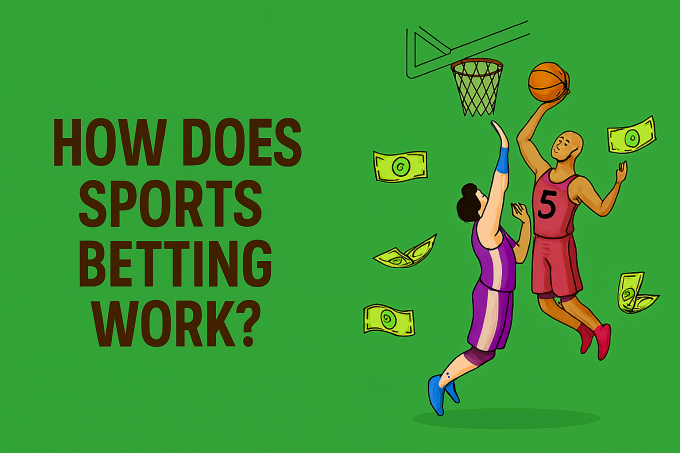As the Gambling Academy Expert, I always say this: learning the fundamentals is the smartest first step before placing real money on sports.
Spread betting is one of the most useful concepts in sports betting because it helps you understand performance, not only outcomes.
Many beginners look at a betting line and freeze when they see numbers like five point five or seven point five next to a team.
In this guide, I will explain everything from zero knowledge. Think of this as me sitting next to you, breaking things down in simple English.
Sports betting always involves risk, so understanding these ideas will not guarantee results. But it will help you make decisions in a more informed and responsible way.
What Spread Betting Is in Sports
Spread betting is a type of wager where the sportsbook gives each team a virtual margin to balance the competition.
This means the favorite gets a negative number and must win by a certain amount. The underdog gets a positive number and can win or lose by a small amount and still win the bet.
In simple words:
The spread turns a game into a challenge of margins, not only winners and losers.
Example line
• Lakers five point five
• Bulls five point five
This means the Lakers must win by at least six points for a bet on them to succeed.
The Bulls can win or lose by five or fewer.
Why Spreads Exist
From my experience analyzing many sportsbooks, the spread exists for three main reasons:
One It makes uneven games more balanced for bettors.
Two It helps sportsbooks receive money on both sides, reducing their risk.
Three It makes more matchups interesting, especially in leagues where blowouts are common.
Without spreads, many matches would only attract bets on the stronger team, forcing the sportsbook to pay extremely low odds.
The spread creates a more equal market.
How the Spread Works Step by Step
One The favorite receives a negative number
This team is expected to win. They must win by more than the spread.
Two The underdog receives a positive number
This team can lose but still win the bet if they stay within the margin.
Three The result focuses on the margin
The real game winner does not always determine the winning bet.
What matters is whether the chosen team covers the spread.
Four The odds are usually similar on both sides
Many spreads offer odds close to one point ninety or minus one hundred ten in American format.
This keeps the market balanced.
Table One How Favorites and Underdogs Work
| Team Type | Spread Number | Requirement to Win the Bet |
| Favorite | Negative value | Must win by more than the spread |
| Underdog | Positive value | Can win or lose within the margin |
Key Terms You Must Know
Cover
A team covers when it achieves the required margin.
Fail to cover
A team fails to cover when it does not meet the required margin.
Push
If the spread is a full number like five and the team wins by exactly five, nobody wins or loses. The bet is refunded.
Half point
Sportsbooks often use half points like five point five to avoid the push scenario.
Simple and Advanced Examples
Simple Example One Spread of five point five
• Barcelona five point five
• Valencia five point five
Barcelona covers if they win by six or more.
Valencia covers if they win or lose by five or fewer.
Simple Example Two Spread of three point five
• Patriots three point five
• Jets three point five
Jets with three point five win the bet even if they lose the match by three.
Advanced Example One When the game is close
Imagine a basketball match:
• Heat two point five
• Knicks two point five
A two point loss from the Heat means your bet fails even if the match was extremely tight.
Advanced Example Two When injuries matter
If the quarterback of a football team is injured before the match, the spread may move from seven point five to four point five.
This means the sportsbook reassessed the power of the team.
Table Two Example Outcomes
| Spread | Team A Result | Team B Result | Who Covers |
| five point five | Wins by eight | Loses | Team A |
| five point five | Wins by three | Loses | Team B |
| three point five | Loses by two | Wins | Team A |
| two point five | Wins by one | Loses | Team B |
Spread vs Moneyline
Moneyline
You simply choose who wins.
It is straightforward but often offers low payouts on favorites.
Spread
You choose whether a team performs above or below an expected margin.
This creates a more even payout structure.
Moneyline equals winner prediction
Spread equals margin prediction
Both are useful, but spreads allow deeper analysis of team performance.
How Sportsbooks Create Spreads
Sportsbooks use a mix of statistical models, power rankings, injuries, home advantage, travel distance, rest days, and betting patterns to calculate spreads.
From what I have observed, there are four main components:
One Team strength ratings
Two Matchup specific factors
Three Public betting tendencies
Four Real time news and player availability
This is why spreads rarely stay still.
Line Movement Explained
A moving line means the sportsbook is adjusting the spread due to:
• Heavy betting on one side
• Injury updates
• Weather changes
• Market corrections
• Unexpected team announcements
Knowing how to read line movement helps you avoid bad bets.
Example
A spread moves from five point five to four.
This indicates the underdog is receiving strong support or the favorite is losing confidence from bettors.
Table Three Reasons for Line Movement
| Reason | Description | Impact on Spread |
| Heavy betting | Too much money on one team | Spread shifts to balance the market |
| Injury news | A key player is out | Spread adjusts instantly |
| Weather | Strong wind or rain | Lowers spreads in football |
| Public bias | Popular team gets excessive bets | Sportsbook widens line |
Pros of Spread Betting
Clear benefits
• Works well in uneven matchups
• Creates balanced odds
• Reduces the need to choose low value moneyline favorites
• Encourages strategic thinking
• Helps you read real performance levels
Cons of Spread Betting
Potential downsides
• Harder for beginners than simple winner prediction
• Half points can make losses feel frustrating
• Line movement can confuse new bettors
• Requires more analysis and patience
Common Mistakes and Best Practices
Common Mistakes
❌ Believing favorites always cover
❌ Ignoring injuries or workload
❌ Betting on team names instead of data
❌ Entering a bet without researching line movement
❌ Betting emotional games like rivalries
Best practices
✔ Check team form and health
✔ Understand the spread number deeply
✔ Review line movement before betting
✔ Bet small amounts while learning
✔ Avoid betting when you feel rushed or pressured
How to Choose and Apply a Spread
Step One Identify the favorite and underdog
Look at the sign of the number.
Step Two Evaluate if the margin is realistic
Ask yourself if the team can truly exceed that number.
Step Three Consider context
Travel, fatigue, motivation, style matchups, and injuries all matter.
Step Four Compare odds across sportsbooks
Small differences can improve long term results.
Step Five Decide whether the spread or moneyline makes more sense
Sometimes the safer option is choosing a winner instead of the margin.
When Not to Use a Spread
There are moments when avoiding spreads is the smarter move:
• When you do not trust the favorite to maintain intensity
• When the match involves unpredictable teams
• When injury news is unclear
• When weather conditions make performance unpredictable
• When both teams are inconsistent
Avoiding bets is also a betting decision. Smart players know when to skip.
Why Understanding the Spread Matters
Learning spreads helps you:
• Analyze games beyond win or lose
• Avoid emotional choices
• Predict performance trends
• Think like a sportsbook
• Improve your discipline and reasoning
At Gambling Academy, education comes before action. Understanding spreads gives you a safer and smarter foundation.
Responsible Gaming
Understanding the spread does not change one key truth: sports betting always carries financial risk.
Bet only what you can afford to lose.
If betting feels stressful, step away.
Always follow local laws and age limits.
Your well being matters more than any match or margin.
Conclusion
The spread is one of the core ideas in sports betting.
It transforms games into margin challenges and rewards thoughtful analysis, not just guesswork.
Now that you understand spreads, your next step is learning how odds work and how totals operate. Those concepts complete the beginner foundation.
FAQs
One Does the spread always include decimals
No. A full number can create a push where your stake is refunded.
Two What does cover mean
It means your chosen team exceeded the expected margin.
Three Is spread betting harder than moneyline
It requires more strategy but many learners find it fairer.
Four Why does a spread move before a game
Because of injuries, weather, or heavy betting on one side.
Five Can spreads be included in parlays
Yes, but the risk increases significantly.
Six Do low scoring sports use spreads
Yes, baseball has the run line and hockey has the puck line.
Seven Do spreads affect the odds
Usually yes. Both sides usually sit near one point ninety.
Eight Is spread betting always the best option
No. Sometimes moneyline or totals offer a safer approach.











